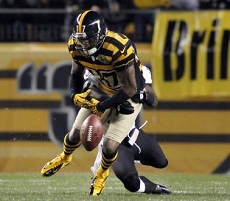[adsenseyu1]
A few weeks ago Jason LaCanfora published a list of best and worst contracts in the NFL so I thought it might make a good idea for us to do the same here at OTC, with a team by team approach. I’ll try to be a bit more analytical in terms of why money was paid and how it fits in the market, but the general premise is the same. The one key difference is outside of restructured rookie contracts under the old CBA we will only use veteran contracts as there is a big difference between best draft picks and best contracts. Please note that there is a difference between a bad player and a bad contract when discussing some of the selections. Clicking on a players name will take you to his salary cap page.
Best Contract: Cameron Wake
This is a no brainer. Wake is the best defensive player in the NFL and was close to the best defensive player in the NFL when he signed his contract in 2012. While I am not a fan of the Dolphins front office or their handling of contracts they hit a home run with Wake. Jeff Ireland steamrolled Wake, who was a in the final year of a low cost contract, into accepting a contract that offered little protection as he got older and the need to continue to perform at a high level in order to earn incentives to bump the value of his contract to a reasonable level.
Wake’s APY ranks behind that of Chris Long, Trent Cole, Jared Allen, Charles Johnson, Tamba Hali, Terrell Suggs, Lamarr Woodley, and so on. The base value of his contract is about 48% less than that of Mario Williams. In the last three years Wake has produced 37.5 sacks and 191 additional pressures while Williams has produced 24 and 113. Even if Wake hits his upside values he will only be compensated around the levels of Hali. Wake’s lowball deal may have been the impetus that has made teams rethink
the spending that they thought they were forced to allocate to premier pass rushers as the market has declined greatly following the Wake contract.
Whether it was an over-reliance on a fluke sack conversion stat or something else off his 2011 season, Wake took a deal that will never push his cap number beyond $9.8 million on the base value of the contract. His cap number this season is only slightly above $5 million and in 2015, when he turns 33, there is only $2.8 million of dead money on the books if they decide to release him. Quite frankly he’ll probably be in a position where he may be forced into a paycut. It was this bargain deal that allowed Miami to spend wildly in the 2013 offseason and the deal is arguably the best non-rookie contract in all of the NFL.
Worst Contract: Mike Wallace
The Dolphins spent tons of money in 2013 on multiple long term contracts which raised questions among observers as to what the Dolphins were seeing in some of the players. None typified that response more than Wallace. The Dolphins have taken an amazing risk on Wallace, paying him $12 million a year on a cap killing contract hoping that he can be what Plaxico Burress was to Eli Manning or what Calvin Johnson currently is to Matthew Stafford.
For the first time in his career Wallace is going to be asked to be the primary target on a team. He is no longer going to be that deep threat running down the sidelines while teams have to guess where to roll coverage. He is going to be the man. Statistically his previous three seasons compared closer to that of DeSean Jackson and Santonio Holmes in terms of team contribution at time of signing, players more in the $9 million dollar a year range than the elite category the Dolphins priced Wallace in. Like those two Wallace has also shown some maturity issues that seemed to pull his play down last season. Miami has to hope that paying him the money he wanted brings out a renewed interest for a player whose numbers were down across the board last year. Wallace currently ranks 4th in the NFL in compensation at the position.
The contract structure pushed the deal for me into clear worst category. In order to make his cap hit artificially low in 2013, Wallace’s cap number will never be below $12.1 million over the course of the deal. He will earn an additional $3 million in guarantees in 2014 pushing his dead money in 2015 to $9.6 million, assuming Miami does not rework his contract in 2014, when he will carry a $17.25 million dollar cap charge. For Wallace to justify the Dolphins investment he is going to have to produce somewhere between 1,400 and 1,500 yards. That is a tall task for almost any WR in the NFL.
[adsenseyu2]

